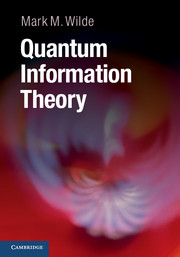Book contents
- Frontmatter
- Contents
- How To Use This Book
- Acknowledgments
- Part I Introduction
- Part II The Quantum Theory
- Part III Unit Quantum Protocols
- Part IV Tools of Quantum Shannon Theory
- Part V Noiseless Quantum Shannon Theory
- Part VI Noisy Quantum Shannon Theory
- 19 Classical Communication
- 20 Entanglement-Assisted Classical Communication
- 21 Coherent Communication with Noisy Resources
- 22 Private Classical Communication
- 23 Quantum Communication
- 24 Trading Resources for Communication
- 25 Summary and Outlook
- Appendix A Miscellaneous Mathematics
- Appendix B Monotonicity of Quantum Relative Entropy
- References
- Index
21 - Coherent Communication with Noisy Resources
from Part VI - Noisy Quantum Shannon Theory
Published online by Cambridge University Press: 05 May 2013
- Frontmatter
- Contents
- How To Use This Book
- Acknowledgments
- Part I Introduction
- Part II The Quantum Theory
- Part III Unit Quantum Protocols
- Part IV Tools of Quantum Shannon Theory
- Part V Noiseless Quantum Shannon Theory
- Part VI Noisy Quantum Shannon Theory
- 19 Classical Communication
- 20 Entanglement-Assisted Classical Communication
- 21 Coherent Communication with Noisy Resources
- 22 Private Classical Communication
- 23 Quantum Communication
- 24 Trading Resources for Communication
- 25 Summary and Outlook
- Appendix A Miscellaneous Mathematics
- Appendix B Monotonicity of Quantum Relative Entropy
- References
- Index
Summary
This chapter demonstrates the power of both coherent communication from Chapter 7 and the particular protocol for entanglement-assisted classical coding from the previous chapter. Recall that coherent dense coding is a version of the dense coding protocol in which the sender and receiver perform all of its steps coherently. Since our protocol for entanglement-assisted classical coding from the previous chapter is really just a glorified dense coding protocol, the sender and receiver can perform each of its steps coherently, generating a protocol for entanglement-assisted coherent coding. Then, by exploiting the fact that two coherent bits are equivalent to a qubit and an ebit, we obtain a protocol for entanglement-assisted quantum coding that consumes far less entanglement than a naive strategy would in order to accomplish this task. We next combine this entanglement-assisted quantum coding protocol with entanglement distribution (Section 6.2.1) and obtain a protocol for which the channel's coherent information (Section 12.5) is an achievable rate for quantum communication. This sequence of steps demonstrates an alternate proof of the direct part of the quantum channel coding theorem stated in Chapter 23.
Entanglement-assisted classical communication is one generalization of superdense coding, in which the noiseless qubit channel becomes an arbitrary noisy quantum channel while the noiseless ebits remain noiseless. Another generalization of super-dense coding is a protocol named noisy super-dense coding, in which the shared entanglement becomes a shared noisy state ρAB and the noiseless qubit channels remain noiseless.
- Type
- Chapter
- Information
- Quantum Information Theory , pp. 508 - 531Publisher: Cambridge University PressPrint publication year: 2013

